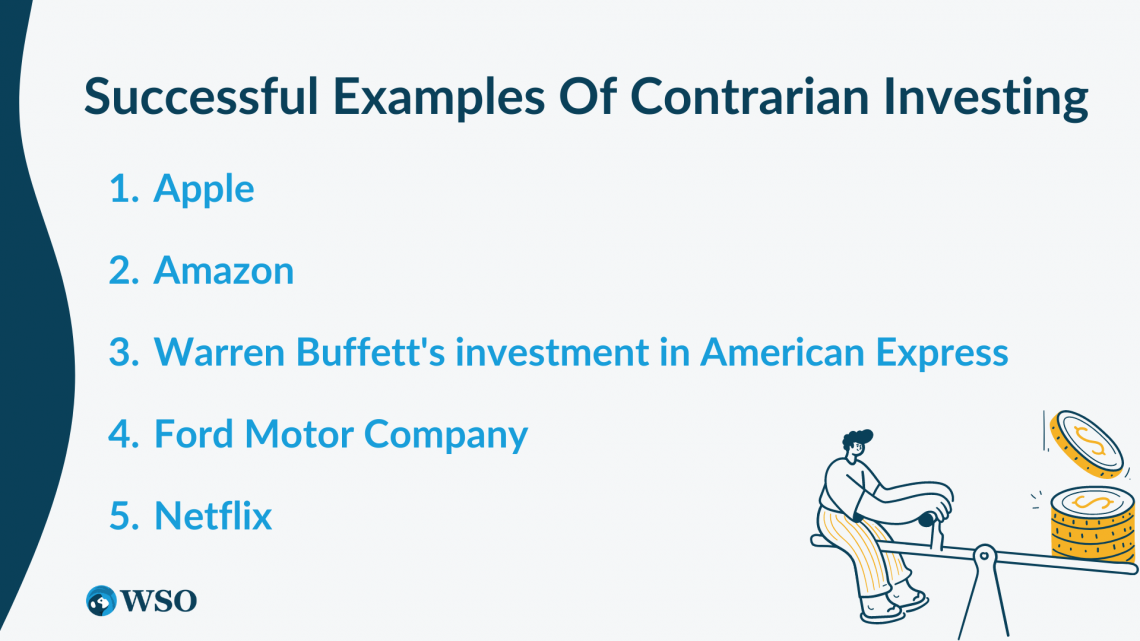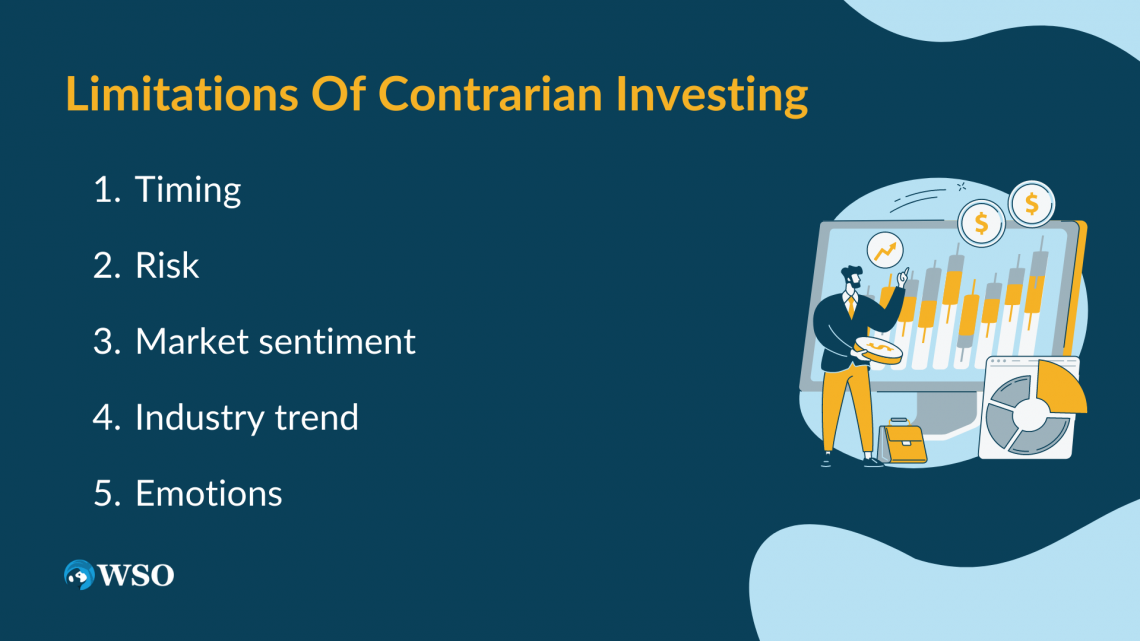Contrarian Investing
It involves taking positions that pass in opposition to the winning market sentiment and expectancies.
Investing is vital in constructing wealth, but it could be difficult to find worthwhile funding possibilities.

One technique that has won popularity through the years is contrarian investing. It includes searching out shares that are trading beneath their intrinsic value to purchase them at a discount and profit while the market, in the end, corrects itself.
The key principle behind it is that the marketplace isn't usually green and may every so often misprice shares.
Contrarian investors search to take advantage of those inefficiencies using conducting fundamental analyses and identifying stocks that might be undervalued due to transient factors or marketplace overreactions.
It has an extended record of achievement, with several of the most successful buyers on record, including Warren Buffett and Benjamin Graham, using a value-orientated method to build their fortunes.
However, price-making an investment isn't always without its dangers, and traders want to be privy to these dangers earlier than implementing a cost method.

It challenges the notion of "going with the flow" in the financial markets, as it embraces the idea that true value can often be found in areas where others fear to tread.
This investment approach requires a contrarian mindset that is able to withstand short-term market volatility and noise, with a focus on the long-term potential of undervalued assets.
Contrarian investors aim to seize opportunities created by market inefficiencies, emotional biases, and the tendency of investors to overreact to short-term news or trends.
Through a disciplined and patient approach, contrarian investors strive to buy low and sell high, taking advantage of the market's tendency to swing between excessive optimism and pessimism.
Key Takeaways
- Contrarian investing involves taking positions that pass in opposition to the winning market sentiment and expectancies.
- It may be a worthwhile approach for generating tremendous returns, but it isn't always without risks.
- Contrarian investors look for opportunities where the market is mispriced or undervalued because of short-term elements.
- Successful contrarian traders have a long-term investment method and a varied portfolio to limit the effect of any losses.
- The barriers of contrarian investing encompass the difficulty of predicting marketplace sentiment and the chance of investing in corporations that might be unable to turn their organizations around.
- Examples of successful contrarian investments consist of Warren Buffet's purchase of American Express and Sir John Templeton's funding in Japan within the Sixties.
- Examples of incorrect contrarian investments include Blockbuster, Sears Holdings Corp., and Chesapeake Energy Corp.
- To exercise contrarian investing effectively, investors must behave with widespread studies and analysis, have a long-term investment strategy, and have a diverse portfolio.
An Overview of Contrarian Investing
In this article, we will explore the meaning of contrarian investing, the benefits and risks of this investment approach, and providing realistic guidelines on practicing it effectively.

We will delve into the motives of why it works, including the idea of intrinsic value and the capability for widespread profits from undervalued stocks.
Additionally, we can discuss the importance of carrying out fundamental evaluations and staying knowledgeable to become aware of opportunities within the market.
Contrarian investing gives several benefits. Firstly, it lets buyers shop for stocks at a discount, supplying a margin of protection in case of unexpected activities.
Secondly, it can assist in reducing the danger by avoiding hyped-up stocks, which can experience giant charge declines.
However, it additionally comes with its risks. The marketplace can be unpredictable, or even the most diligent buyers can leave out important facts or enjoy unforeseen activities which can cause huge losses.
NOTE
By specializing in businesses with robust fundamentals and a long-time period outlook, price investors can potentially construct a portfolio with lower volatility.
Additionally, it calls for patience and discipline, as it may take time for the market to recognize the actual value of undervalued shares.
In the following sections, we will provide a better look at the principles of it and the way to put in force this strategy correctly.
We will discuss the significance of conducting fundamental evaluations, identifying key monetary metrics, and staying informed about the market and enterprise traits.
With the right information and technique, it can effectively build lengthy-term wealth and rich monetary balance.
Why Contrarian Investing Works?
It works due to the fact it's far based on the concept that the market isn't always rational and might overreact to short-time period information or events.

When wrong information about a corporation emerges, buyers may additionally panic and sell off their stocks, causing the stock charge to drop underneath its intrinsic value.
This creates an opportunity for contrarian investors who buy the stock at a discount, expect the market to correct itself, and the inventory price will push upward.
Contrarian investors agree that the market frequently overreacts to short-term information, inflicting stocks to become undervalued.
This creates an opportunity for contrarian investors to take advantage of the market's overreaction by purchasing undervalued stocks. By taking a count. technique, traders can avoid the herd mentality and position themselves to benefit from future price appreciation.
Another reason why contrarian making an investment works is that it lets investors keep away from overvalued stocks that may be at risk of huge price declines.

Contrarian investors, then again, are trying to find out undervalued stocks and avoid overvalued ones, decreasing the hazard of considerable losses all through marketplace downturns.
Contrarian investing additionally works as it makes a specialty of the long-time period outlook of a company.
By engaging in fundamental analysis and identifying undervalued shares with strong fundamentals and a strong business model, contrarian investors can position themselves to benefit from the company's long-term boom ability.
NOTE
Contrarian investing works because it allows buyers to shop for undervalued shares whilst the market overreacts to short-term period news or events, and keeps away from puffed-up stocks that may be vulnerable to large rate declines.
This technique requires endurance and discipline, as it can take time for the market to understand the authentic value of undervalued shares.
However, by holding onto undervalued stocks long-term, contrarian traders can obtain full gains while the market finally corrects itself.
By focusing on the long-term outlook of an organization and conducting fundamental analysis, contrarian investors can position themselves to take advantage of future price appreciation and obtain lengthy-term wealth.
How to Practice Contrarian Investing?
Practicing it calls for a disciplined and affected personal approach that involves identifying and keeping undervalued stocks for a long time. Here are some practical tips for practicing it:

1. Conduct fundamental evaluation
It ought to look past short-time period news and cognizance of an enterprise's long-time period growth capacity.
This entails undertaking essential analysis, which includes analyzing a company’s financial statements, management team, and competitive landscape.
By reading these elements, buyers can become aware of undervalued shares with robust fundamentals and a stable commercial enterprise model.
2. Identify key financial metrics
When analyzing an employer, contrarian buyers should pay interest to key financial metrics: the price-to-earnings ratio (P/E), price-to-book ratio (P/B), and dividend yield.
These metrics can assist traders in determining if a stock is undervalued relative to its peers and provide insights into an organization's future growth capability.
3. Stay knowledgeable
Contrarian traders need to stay informed about enterprise tendencies and information that would affect an employer's future growth potential.
NOTE
By staying informed, investors can discover undervalued shares earlier than the market corrects itself and take advantage of purchasing possibilities.
4. Practice discipline and patience
It requires patience and discipline, as it can take time for the market to understand the actual value of undervalued stocks.
Investors must avoid the temptation to sell their stocks during market downturns and, as a substitute, maintain them for the long term.
5. Diversify your portfolio
As with any investment method, it is critical to diversify your portfolio to reduce risk. Contrarian buyers should no longer rely upon an unmarried stock or industry and, as an alternative, unfold their investments throughout multiple sectors and asset training.
Practicing it involves undertaking fundamental analysis, identifying key monetary metrics, staying knowledgeable, practicing discipline and patience, and diversifying your portfolio.
By following those standards, contrarian traders can position themselves to advantage from future price appreciation and gain long-term wealth.
Successful examples of Contrarian Investing
It may be a successful method for buyers willing to take a long-term approach and persistently maintain undervalued shares through market downturns. Here are some examples of successful contrarian investments:

1. Apple
In the early 2000s, Apple Inc. suffered from declining income and a stagnant product line. However, Steve Jobs returned as CEO in 1997 and released the iPod in 2001, followed by the iPhone in 2007.
Contrarian investors who recognized Apple's ability for growth and investment in the organization all through this era have seen good-sized returns on their investment, as Apple has emerged as one of the most precious companies in the international market.
2. Amazon
Amazon.Com, Inc. was founded in 1994 as a web bookstore and struggled to show an income for years. However, CEO Jeff Bezos remained committed to investing in the agency's long-term boom and increasing into new markets.
Contrarian buyers who invested in Amazon.com during this era have seen tremendous returns on their investment because the organization has grown to dominate e-trade and extended into different areas, including cloud computing.
3. Warren Buffett's investment in American Express
In the mid-1960s, American Express was going through a scandal, including unapproved card charges, making its stock cost fall.
NOTE
While most extreme traders have been selling their shares, Warren Buffett recognized the corporation's long-term potential and put vigorously in its stock.
After some time, American Express recovered from the scandal and has become quite possibly one of the best financial service companies in the world, delivering enormous returns for Buffett and other contrarian investors.
4. Ford Motor Company
Right after the financial crisis of 2008, numerous traders have been selling their stocks in Ford Motor Company due to stresses over the organization's debt levels and declining income.
However, contrarian investors who recognized areas of strength for Ford and long-term period capacity contributed to the business's stock.
Over the accompanying years, Ford changed into a fit to pivot its commercial enterprise, improving its financial role and turning into a productive business enterprise once more, bringing about incredible returns for contrarian investors.
5. Netflix
In the mid-2010s, Netflix, Inc. changed to managing contest from other streaming services and battled to keep its market strength. However, CEO Reed Hastings stayed focused on making an investment in unique content and venturing into new markets.
Contrarian investors who perceived Netflix's capacity for the increment and contributed inside the organization for the length of this period have seen sizable profits from their investment, as Netflix has come to be quite possibly the best streaming service in the world.

In these cases, contrarian investors had been equipped to find underestimated stocks that the market had ignored or underestimated.
They perceived that those organizations had sturdy hidden basics and a solid enterprise version and were ready to protect their investments for quite a while, in any event, when the market became negative on these shares.
While it tends to be a fruitful approach, it isn't without risks. Contrarian buyers need good-sized examinations and investigations to select underestimated shares and have the perseverance to save these shares utilizing market downturns.
They likewise need to live knowledgeable about enterprise developments and news that could influence an organization's destiny boom capacity.
NOTE
For traders willing to take an extended-time approach and persistently keep onto undervalued shares, contrarian investing can be a profitable method for producing full-size returns on their investments.
Limitations of Contrarian Investing
While it may be a worthwhile method, it isn't always without boundaries. Here are a number of the restrictions of it:

1. Timing
Contrarian investors need to be patient and willing to maintain undervalued shares for a lengthy-time period, even when the market is bearish on those shares.
However, it could be tough to time the marketplace and determine when a stock has hit its bottom and is undervalued. This requires enormous research and evaluation and a willingness to watch for the proper opportunity to make investments.
2. Risk
It can be risky, as investors regularly buy stocks that can be out of style with the marketplace. These stocks can be undervalued for a reason, such as declining income or high tiers of debt.
Investors need to conduct substantial studies and evaluations to become aware of undervalued stocks with strong underlying basics and a solid enterprise model.
3. Market sentiment
Contrarian traders want to be aware of market sentiment and how it can impact their investments. When the marketplace is bullish, it may be hard to locate undervalued stocks which are out of fashion with investors.
NOTE
When the marketplace is bearish, putting money into undervalued shares that might not have a strong future increase capacity may be tempting.
4. Industry trend
contrarian buyers need to stay informed about industry trends and information that could impact an employer's future growth potential.
A contrarian investment may be undervalued because the enterprise it operates in is in decline, or new technology or disruptors could affect the employer's future profits capability.
5. Emotions
It requires discipline and the capability to remain calm in the face of marketplace volatility. Many investors battle with emotional biases that could lead them to make terrible funding decisions, including selling undervalued stocks all through market downturns.
Ultimately, it may be a profitable strategy for investors inclined to take a long-term approach and feature the endurance to keep onto undervalued stocks through marketplace downturns.
NOTE
It is crucial to recognize the constraints of this approach, consisting of the need for extensive research and analysis, the dangers concerned, the effect of market sentiment and enterprise tendencies, and the need to manipulate emotions.
Investors who are capable of navigating these boundaries can probably generate considerable returns on their investments through contrarian investing.
Where Contrarian Investing Went Wrong
It is not usually a hit method, and there were times when it was incorrect. Here are a few examples of contrarian investments that have not worked out:

1. Blockbuster
In the early 2000s, Blockbuster became a dominant player within the video rental industry but changed into dealing with expanded opposition from online streaming services like Netflix.
Contrarian traders who believed that Blockbuster could be able to adapt to the changing enterprise invested within the corporation's inventory.
However, Blockbuster could not compete with the convenience and cost-effectiveness of online streaming offerings and filed for bankruptcy in 2010, resulting in significant losses for contrarian investors.
2. Sears Holdings Corp.
In the mid-2010s, Sears Holdings Corp. faced declining sales and mounting debt, causing many traders to abandon the organization's stock.
However, contrarian investors who believed in the electricity of the company's brand and its capability for a turnaround invested in the inventory.
Unfortunately, Sears could not reverse its declining income and, in the end, filed for bankruptcy in 2018, resulting in big losses for contrarian traders.
3. Chesapeake Energy Corp.
In the early 2010s, Chesapeake Energy Corp. was a main participant in the natural gasoline industry but faced mounting debt and declining income.
Contrarian traders who believed in the agency's long-time period capability invested inside the inventory but were, in the long run, upset as Chesapeake Energy Corp. Persevered to war and sooner or later filed for financial disaster in 2020.
In every one of those cases, contrarian investors have been betting on organizations that have been dealing with giant challenges and have been unable to turn their agencies around.
Contrarian investing may be a good strategy for generating vast returns on investments, however, it is not without risks. There were times when Contrarian Investments have gone incorrect, ensuing in tremendous losses for investors.
NOTE
Investors who are thinking about contrarian investments need to carefully research and examine the company they are investing in, in addition to having a long-term investment approach and a varied portfolio to reduce the impact of any losses.
Contrarian Investing FAQs

Some key traits of a successful contrarian investor encompass the capacity to pick out mispricings within the marketplace, conduct thorough studies and evaluations, have a long-term investment method, keep discipline, and have a diversified portfolio.
It may not be suitable for all investors, especially folks who are chance-averse or do not have the knowledge or subject to enforce a long-term investment strategy.
One common false impression about it is that it's a matter of buying low and selling excessively.
However, successful contrarian investing involves greater than simply timing the market. It requires considerable research and analysis to determine undervalued possibilities and a long-term investment strategy.
Some risks related to contrarian investing encompass the potential for significant losses if the marketplace sentiment is still terrible, the danger of investing in organizations that are not able to turn their organizations around, and the issue of predicting market sentiment as it should be.
Investors can identify contrarian opportunities by looking for organizations or properties that are undervalued because of short-term factors, including negative news or a transient decline in income.
Investors also can look for industries or sectors which are out of style with the marketplace due to cyclical or structural factors.
To avoid the temptation to observe the herd, buyers must increase a long-term investment strategy and maintain discipline in their investment decisions.
This may also contain warding off short-time period marketplace noise and focusing on the underlying basics of an enterprise or asset. Investors should also be willing to admit that investment isn't working out and reduce their losses if necessary.





or Want to Sign up with your social account?